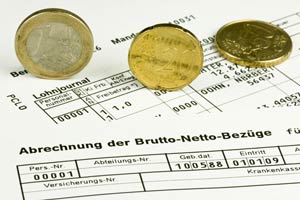Current
informs.
All news at a glance.

We keep you up to date
We bring you the latest developments and news directly to your screen!
Current dates and developments always in view.
Payment of the EPP by the employer
For most employees, the EPP should be paid by the employer, but this is not always easy due to special cases and detailed regulations.
As a rule, the employer should pay the EPP with the payroll for September to all employees who are employed by him in a first employment relationship on September 1, 2022. Only employers who either do not file a payroll tax return (e.g. because they only employ mini-jobbers) or who only file a payroll tax return annually are exempt from this payment obligation. In the second case, the employer can make the payment, but does not have to.
The employees to whom the employer must pay the EPP are determined by the following rules:
-
Deadline: The requirements for a payment by the employer must be fulfilled on the cut-off date of September 1, 2022 be. If the active employment relationship ends before the cut-off date or begins even one day later, the employer is not responsible for paying the EPP and is not entitled to do so. There can therefore be no double payments in the event of a change of employer. Provided that there is no employment relationship with any other employer on the reference date, which would then be responsible for payment, employees can receive the EPP in the coming year by filing a tax return for 2022.
-
First employment: Entitlement to the EPP exists only within the scope of the first permanent employment relationship. Payment by the employer therefore requires that the employee falls into tax classes I to V or, as a mini-jobber, confirms to the employer in writing that this is the first employment relationship. Employees in tax class VI, mini-jobbers with another employment relationship, short-term employees and temporary workers in agriculture and forestry thus do not receive EPP from the employer. However, short-term employees and temporary workers can receive the EPP in the coming year by submitting a tax return for 2022.

-
Payroll: Payment of wages by the employer is not a prerequisite for entitlement to the EPP, nor is it sufficient for entitlement to the EPP. The employer must therefore pay the EPP also the employees who are still in active employment, but who have not yet been Temporarily no wage payment receive, for example, because they are temporarily on leave or are receiving sick pay, maternity pay or parental allowance. However, the employee must prove receipt of parental allowance to the employer in order to be eligible for payment of EPP by the employer. Conversely, employees whose Employment relationship already terminated but who are still receiving wages (e.g. early retirement benefits or transitional benefits for a former member of the Executive Board) or a company pension subject to wage tax, no claim on the payment of the EPP by the former employer.
-
Domestic reference: Employees with limited tax liability are not entitled to the EPP. The payment of the EPP by the employer therefore presupposes that the employee has paid his/her Residence or habitual abode in Germany has. If the employee moved from or to a foreign country in 2022, it depends on the date of the move. For employees who moved abroad before September 1, 2022 (change from unlimited to limited tax liability), the employer should still pay the EPP if the employment relationship continues on the effective date. Employees who moved to Germany after September 1, 2022 (change from limited to unlimited tax liability), on the other hand, will not receive the EPP from the employer. Such employees can only receive the EPP by submitting an income tax return for the year 2022.
If all requirements for payment of EPP by the employer are met, the employer shall pay EPP in September 2022. It does not matter which payroll month is settled in September 2022. If payroll is not run until the following month due to operational reasons and therefore payroll is not run until August 2022 in September 2022, the payment should still be made in September. Employers who only submit their payroll tax returns on a quarterly basis may pay the EPP in October 2022 as an exception to the rule.

If the payment cannot be made on time in September 2022 for organizational or accounting reasons, the tax authorities have no objections if the payment is made with the payroll for a later payroll period in 2022. However, the payment and settlement must be made at the latest by the time the wage tax statement is sent to the employee.
In addition, to mini-jobbers taxed at a flat rate, the employer may not pay the EPP until a written confirmation of the employee about the first employment relationship is available (see "Sample confirmation of first employment"). This confirmation must be taken to the payroll account and kept. The employer is not obliged to check the accuracy of the confirmation, but may rely on the information provided by his employee.
The tax authorities have not specified whether the confirmation must already be available on the reporting date of September 1, 2022. It should therefore also be possible to submit the confirmation at a later date, for example because the employee is temporarily ill. However, payment is only possible after the confirmation has been submitted.
The EPP is not a salary and therefore not income subject to social security contributions. For this reason, the EPP is not counted towards the 450 euro limit (520 euro limit from October) for mini-jobbers or the minimum contribution for a Riester pension. However, the EPP paid out by the employer is subject to income tax deduction as other remuneration. However, it is not to be taken into account when calculating the lump-sum pension allowance as part of the wage tax calculation because no social security contributions are due on the EPP.
The payment of the EPP must be made by the employer in the electronic wage tax certificate for 2022 through the Capital letters E document. This gives the tax office the opportunity to identify possible double payments. Until the wage tax certificate for 2022 is issued, corrections and subsequent payments or reclaims of the EPP are still possible, e.g. because the employer subsequently becomes aware that the main employer has changed as of the cut-off date.
For mini-jobbers for whom the employer has levied the wage tax on a flat-rate basis, no wage tax certificate is to be issued even if the EPP is paid to the employee. If the employee files an income tax return for 2022, he must himself state in the income tax return that he has already received the EPP from the employer.
Refinancing of the payment via the advance income tax paymentFor refinancing purposes, employers may take the EPP paid to their employees from the withheld wage tax. If the total EPP to be granted exceeds the wage tax to be withheld, the employer is reimbursed the excess amount by the tax office to which the wage tax is to be withheld. When this is the case depends on whether the wage tax is paid monthly, quarterly or annually:
-
Monthly payer: The EPP must be reported on the August payroll tax return due on September 12, 2022, and paid to employees in September.
-
Quarterly payers: In the case of a quarterly payroll tax return, the EPP is offset against the payroll tax return for the III quarter due on October 10, 2022. The employer may decide whether to pay the lump sum in advance in September or only after offsetting with the tax office in October.
-
Annual payer: Employers who only pay payroll tax annually are not required to make EPP payments. If the employer pays the lump sum anyway, the offset is provided for in the annual tax return due on January 10, 2023.
Due to the legal requirement, the refinancing cannot be postponed. Even in the event of a later payment, September 12, 2022 will remain the cut-off date for the refinancing of the EPP in the case of monthly filings. The Federal Ministry of Finance has already published an amended form for the 2022 payroll tax return, which includes a new field with the code 35 for EPP. This field may only be completed in the August 2022, 3rd quarter 2022 and annual 2022 filing periods. Therefore, if the EPP is changed at a later date, the corresponding filing must be corrected.
The payment of the EPP to the employees is an operating expense, the refinancing via payroll tax is an operating income. As a result, the payment transactions for the EPP have no effect on profits at the employer. Costs associated with the payment of the EPP are not reimbursed by the tax office. However, these are to be taken into account as operating expenses.
Sample confirmation of the first employment relationshipIn order for mini-jobbers to be paid the EPP by the employer, they must first declare to the employer in writing that this is the first employment relationship. A specific form for this confirmation is not prescribed. However, the tax authorities have suggested the following formulation:
"I hereby certify ........ (Employee) that my employment relationship existing on September 1, 2022 with ........ (Employer) is my first employment (principal employment). I am aware that if I make an incorrect statement, this may constitute a tax offense or misdemeanor.
Note: Each eligible person is entitled to the flat-rate energy allowance only once, even if several activities are performed in 2022. In cases of marginal employment (mini-job), the employer may only pay the flat-rate energy price to the employee if the employment is the first employment relationship (main employment relationship). This is to prevent the lump-sum energy price allowance from being paid to an employee more than once."